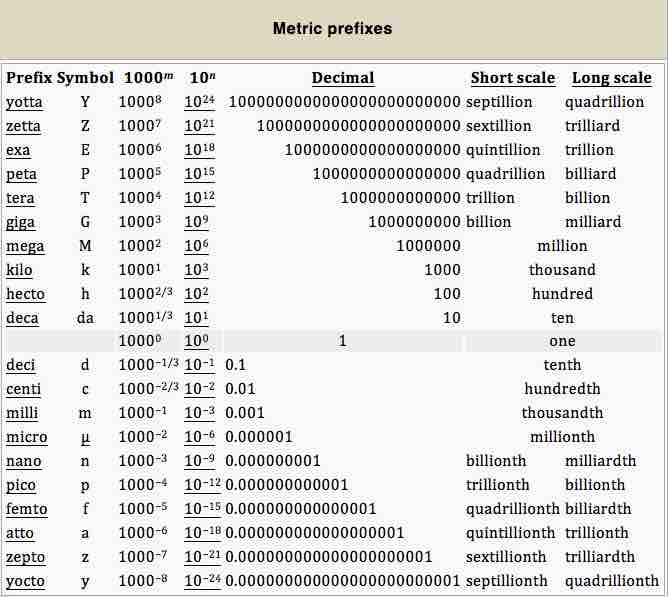Prefixes
A metric prefix, or SI prefix, is a unit prefix that precedes a basic unit of measure to indicate a multiple or fraction of the unit. Each prefix has a unique symbol that is prepended to the unit symbol. The prefix kilo-, for example, may be added to gram to indicate multiplication by one thousand; one kilogram is equal to one thousand grams (1 kg = 1000 g). The prefix centi-, likewise, may be added to meter to indicate division by one hundred; one centimeter is equal to one hundredth of a meter (1 cm = 0.01 m). Prefixes in varying multiples of 10 are a feature of all forms of the metric system, with many dating back to the system's introduction in the 1790s. Today, the prefixes are standardized for use in the International System of Units (SI) by the International Bureau of Weights and Measures.There are twenty prefixes officially specified by SI .

SI Unit Prefixes
The twenty prefixes officially specified by the International System of Units
It is important to note that the kilogram is the only SI unit with a prefix as part of its name and symbol. Because multiple prefixes may not be used, in the case of the kilogram the prefix names are used with the unit name "gram" and the prefix symbols are used with the unit symbol "g. " With this exception, any SI prefix may be used with any SI unit, including the degree Celsius and its symbol °C.
Other Systems of Units
The SI Unit system, or the metric system, is used by the majority of countries in the world, and is the standard system agreed upon by scientists and mathematicians. Colloquially, however, other systems of units are used in many countries. The United States, for example, teaches and uses the United States customary units. This system of units was developed from the English, or Imperial, unit standards of the United Kingdom.The United States customary units define measurements using different standards than those used in SI Units. The system for measuring length using the United States customary system is based on the inch, foot, yard, and mile. Likewise, units of area are measured in terms of square feet, and units of capacity and volume are measured in terms of cubic inches, cubic feet, or cubic yards. Units of mass are commonly defined in terms of ounces and pounds, rather than the SI unit of kilograms.Other commonly used units from the United States customary system include the fluid volume units of the teaspoon, tablespoon, fluid ounce, US cup, pint, quart, and gallon, as well as the degrees Fahrenheit used to measure temperature.
Some units that are widely used are not a part of the International System of Units and are considered Non-SI Units. These units, though not officially part of SI Units, are generally accepted for use in conjunction with SI units. These can include the minute, hour, and day used in temporal measurements, the liter for volumetric measurements, and the degree, minute, and second used to measure angles.